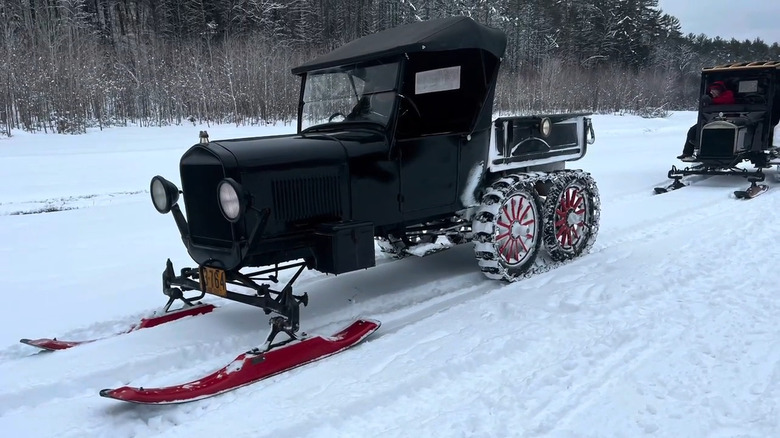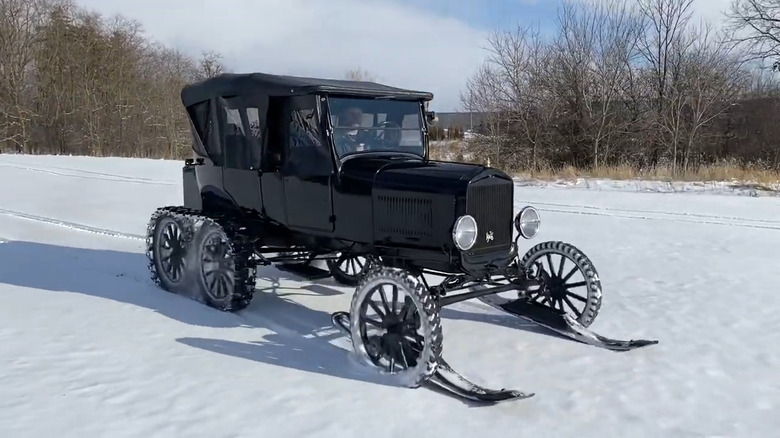Ford Model T Snowmobiles Were Real, And They Still Exist Today
When the Model T rolled out of Ford's Highland Park Plant in 1908 for as little as $260, that first mass-produced automobile took Detroit's renown for building cars to another level and helped firmly establish itself as Motor City. The hand crank-starting Tin Lizzie was the first vehicle to have a steering wheel on the left side, came with an optional front windshield (before they were a standard feature), and the transmission was so smooth that virtually anyone could shift the gears. It helped drive an automotive industrial revolution that has since become an essential component of today's global economy.
So, how do Model T Snowmobiles fit in? Well, that "automobile revolution" was part of a much larger Second Industrial Revolution that occurred from the late 19th to early 20th centuries, when some genuinely revolutionary inventions were created (the lightbulb, petroleum refining, the tractor, etc.). Trains, motorcycles, and automobiles made moving about the country easier, and big cities with massive skyscrapers started sprouting up.
Enter Virgil White, an inventor and authorized Ford dealer in the tiny town of West Ossipee, New Hampshire, an area that averages 73 inches of snow each year. As the old saying goes, "Necessity is the mother of invention," so instead of creating a whole new vehicle, White built his first converted Model T "snowmobile" (a term he coined) in 1913. He patented the conversion kit in 1917 but spent the next five years perfecting the design before finally selling it to the general public during the winter of 1922.
The snow automobile conversion kit was ingenious
The conversion kit's design was quite impressive. White removed the vehicle's front wheels and replaced them with metal and wood skis. Rear-mounted caterpillar tracks were installed, but only after removing the rear axle, driveshaft, rear spring, and radius rods. These were replaced by a 7:1 ratio Ford truck worm gear driveline attached to the vehicle's frame with cantilevered semi-elliptical springs fitted with two pairs of heavy-duty wheels to fit the TT rear axle.
Initially, the anti-skip caterpillar tracks were made from metal cleats held together by heavy fabric. White later changed the design to all-metal tracks with stamped steel shoes connected by chain links. The running boards were removed so the track system could operate properly, and were replaced with cast iron steps embossed with the "Snowmobile" name.
White advertised that his Snowmobile could travel through 30 inches of unbroken snow at an average speed of 18 mph, significantly slower than the Model T's top speed of 45 miles per hour, but faster than a standard car that would get stuck in the snow. Henry Ford liked the concept so much that he let White sell his patented kits through Ford dealers for $400, which was more than some versions of the Model T were selling for. White also sold an already-converted Snowmobile for $750. Industrious folks soon discovered that if the front wheels were left on and equipped with treads like the back tires (think today's snow chains), it became a Sandmobile that could get wade through mud and heavy sand used in the Florida Everglades and sent overseas to destinations like South Africa, Algeria, and Egypt.
It helped deliver milk and the mail in rural areas
The Model T Snowmobile came in three different "sizes," called gauges. In the early days, automobiles traveled on dirt roads that horse-drawn wagons and carriages had long used and, as such, were deeply rutted. To address the many different wagon wheel tracks (think of them just like the width between two rails of a train track), White offered a 38-inch and 44-inch gauge (for mounting on a roadster), as well as a 56-inch gauge (for all body styles made before 1926), all for the low price of $395.00.
He reportedly only made about 70 units in 1923, and two years later, sold manufacturing rights to Farm Specialty Manufacturing Company (New Holstein, Wisconsin), who began selling their version of the snow automobile attachment kits in 1926. After targeting people who had jobs in rural, snowy areas, like doctors, mail carriers, and even milkmen, they were able to make about 3,300 Snowmobiles annually through 1929. Another source states the company sold roughly 25,000 kits that got shipped across the country "and even abroad."
A 1926 five-passenger Touring Snowmobile is unique because it kept the car's front wheels but included the front skies (see photo above). Back in 2021, one was listed for sale at $59,900 by Legendary Motorcar Company, but it's unclear if it sold at that price. A few companies still offer modern kits for both the Model T and A today, and the Model T Ford Snowmobile Club (a Chapter of the Model T Ford Club of America founded in 2000) holds regular winter get-togethers to show off their rides, so there's still quite a bit of enthusiasm for these snow automobiles.

